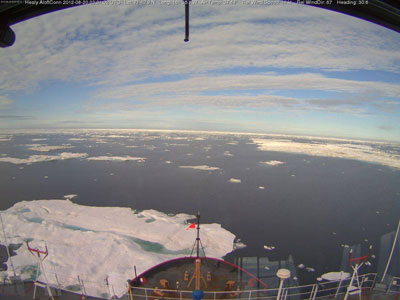Arctic sea ice breaks lowest extent on record
Posted on 28 August 2012 by John Hartz
This article is based on a media advisory posted by the US National Snow and Ice Data Center (NSIDC) on Aug 27, 2012.
![]()
Arctic sea ice cover melted to its lowest extent in the satellite record yesterday, breaking the previous record low observed in 2007. Sea ice extent fell to 4.10 million square kilometers (1.58 million square miles) on August 26, 2012. This was 70,000 square kilometers (27,000 square miles) below the September 18, 2007 daily extent of 4.17 million square kilometers (1.61 million square miles).

Scattered ice floes are seen from the bridge of the RV Healy on August 20, 2012 northwest of Barrow, Alaska. Arctic sea ice fell to its lowest daily extent in the satellite record on Sunday, August 26, 2012. —Credit: U.S. Coast Guard
NSIDC scientist Walt Meier said, "By itself it's just a number, and occasionally records are going to get set. But in the context of what's happened in the last several years and throughout the satellite record, it's an indication that the Arctic sea ice cover is fundamentally changing."
According to NSIDC Director Mark Serreze, "The previous record, set in 2007, occurred because of near perfect summer weather for melting ice. Apart from one big storm in early August, weather patterns this year were unremarkable. The ice is so thin and weak now, it doesn't matter how the winds blow."
"The Arctic used to be dominated by multiyear ice, or ice that stayed around for several years," Meier said. "Now it's becoming more of a seasonal ice cover and large areas are now prone to melting out in summer."
With two to three weeks left in the melt season, NSIDC scientists anticipate that the minimum ice extent could fall even lower.
In 2007, Arctic sea ice extent reached an all-time low in the satellite record that began in 1979. Arctic sea ice follows an annual cycle of melting through the warm summer months and refreezing in the winter. While Arctic sea ice extent varies from year to year because of changeable weather conditions, ice extent has shown a dramatic overall decline over the past thirty years. The pronounced decline in summer Arctic sea ice over the last decade is considered a strong signal of long-term climate warming.
NSIDC will release a full analysis of the melt season in early October, once monthly data are available for September.































 Arguments
Arguments























 0
0  0
0 For what it's worth, this is the area east of Scoresbysund, Greenland, lat 70, on Aug 23.
For what it's worth, this is the area east of Scoresbysund, Greenland, lat 70, on Aug 23.







Comments